UNITED STATES
SECURITIES AND EXCHANGE COMMISSION
Washington, D.C. 20549
FORM N-CSR
CERTIFIED SHAREHOLDER REPORT OF REGISTERED
MANAGEMENT INVESTMENT COMPANIES
Investment Company Act File Number: 811-04521
| T. Rowe Price State Tax-Free Funds, Inc. |
| (Exact name of registrant as specified in charter) |
| 100 East Pratt Street, Baltimore, MD 21202 |
| (Address of principal executive offices) |
| David Oestreicher |
| 100 East Pratt Street, Baltimore, MD 21202 |
| (Name and address of agent for service) |
Registrant’s telephone number, including area code: (410) 345-2000
Date of fiscal year end: February 28
Date of reporting period: August 31, 2019
 |
| Maryland Tax-Free Bond Fund | August 31, 2019 |
| MDXBX | Investor Class |
| TFBIX | I Class |
Beginning on January 1, 2021, as permitted by SEC regulations, paper copies of the T. Rowe Price funds’ annual and semiannual shareholder reports will no longer be mailed, unless you specifically request them. Instead, shareholder reports will be made available on the funds’ website (troweprice.com/prospectus), and you will be notified by mail with a website link to access the reports each time a report is posted to the site.
If you already elected to receive reports electronically, you will not be affected by this change and need not take any action. At any time, shareholders who invest directly in T. Rowe Price funds may generally elect to receive reports or other communications electronically by enrolling attroweprice.com/paperlessor, if you are a retirement plan sponsor or invest in the funds through a financial intermediary (such as an investment advisor, broker-dealer, insurance company, or bank), by contacting your representative or your financial intermediary.
You may elect to continue receiving paper copies of future shareholder reports free of charge. To do so, if you invest directly with T. Rowe Price, please call T. Rowe Price as follows: IRA, nonretirement account holders, and institutional investors,1-800-225-5132; small business retirement accounts,1-800-492-7670. If you are a retirement plan sponsor or invest in the T. Rowe Price funds through a financial intermediary, please contact your representative or financial intermediary or follow additional instructions if included with this document. Your election to receive paper copies of reports will apply to all funds held in your account with your financial intermediary or, if you invest directly in the T. Rowe Price funds, with T. Rowe Price. Your election can be changed at any time in the future.
| T. ROWE PRICE MARYLAND TAX-FREE FUNDS |
HIGHLIGHTS
| ■ | Tax-free municipal bond returns were positive in the six-month period ended August 31, 2019, as interest rates trended lower. |
| ■ | The Maryland Tax-Free Bond Fund outperformed its peer group average for the period, while the Maryland Tax-Free Money Fund and the Maryland Short-Term Tax-Free Bond Fund performed in line with their peer group benchmarks. |
| ■ | Maryland has a long history of responsible stewardship and prudent financial management, but we are closely monitoring the state’s progress in reducing its unfunded pension liabilities. |
| ■ | We believe that municipal bond fundamentals are generally sound. Global economic uncertainties, coupled with heightened geopolitical tensions, could spur continued demand for the asset class. |
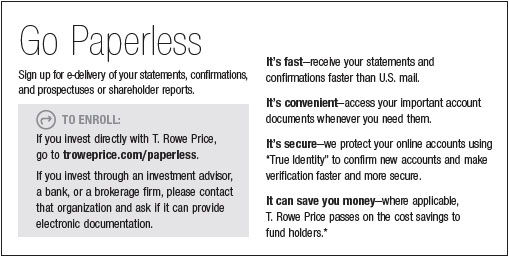
Log in to your account attroweprice.comfor more information.
*Certain mutual fund accounts that are assessed an annual account service fee can also save money by switching to e-delivery.
CIO Market Commentary
Dear Shareholder
Despite rising concerns about tariffs and slower global growth, financial markets delivered generally solid returns in the first half of your fund’s fiscal year, the six months ended August 31, 2019. The large-cap S&P 500 Index reached a record high, and bonds produced strong returns as yields tumbled. However, a strengthening U.S. dollar weighed on returns for U.S. investors in foreign securities.
The period was highlighted by the first Federal Reserve rate cut since 2008. At the end of July, after signaling a shift to a more dovish outlook earlier in the year, Fed policymakers cut their benchmark short-term lending rate by a quarter-point, to a range of 2.00% to 2.25%. In another accommodative gesture, the central bank policymakers announced the end of balance sheet reduction two months earlier than previously planned.
Along with below-target inflation in the U.S., the Fed cited concerns about the impact of decelerating global growth. A slowdown in manufacturing activity was especially notable in Germany, a range of economic indicators in China trended downward through the summer, and waning demand from its trading partners weighed on Japan’s exports.
In contrast, the U.S. economy remained generally healthy during the period. Job growth continued, helping keep the unemployment rate near a 50-year low; wage growth quickened; and consumer demand remained strong. However, manufacturing weakened as it did overseas. The Institute for Supply Management’s gauge of manufacturing activity for August indicated a contraction for the first time since 2016.
Corporate earnings growth declined in the first half of 2019, but, according to FactSet, second-quarter earnings reports for the S&P 500 generally exceeded expectations, helping support stock returns. The S&P 500 reached a record high near the end of July, driven by anticipation of the impending Fed rate cut and optimism for progress in U.S.-China trade talks.
However, the mood quickly shifted on August 1, when President Donald Trump announced that the U.S. would impose a 10% tariff on the roughly $300 billion in Chinese imports not currently facing duties. The news led to the stock market’s biggest intraday plunge since May, and stocks tumbled again when China allowed the yuan to fall below a key threshold with the dollar, raising concerns the trade war was expanding into a currency war.
Despite the August downturn, most U.S. equity benchmarks finished the six-month period with positive results. Large-cap stocks outperformed small-caps, which fell for the period, and growth stocks solidly outperformed value shares.
August’s trade concerns helped spark a rally in safe-haven securities such as U.S. Treasuries. The yield on the 30-year Treasury bond hit a record low in August, falling below the 2% mark for the first time, and the benchmark 10-year Treasury note’s yield fell to its lowest level since 2016. Despite being at or near record lows, Treasuries offered higher yields than many foreign markets, where bond yields were in negative territory. (Bond prices and yields move in opposite directions.)
Yields of shorter-maturity Treasuries did not fall as much, leading to a brief inversion of the closely watched two-year/10-year portion of the yield curve—meaning the shorter-maturity security was yielding more than the longer-maturity Treasury.
Municipal bonds produced solid results but lagged the Treasury rally for the period. Longer-term muni yields reached all-time lows as cash flowed into the muni asset class at a record pace, and the supply of bonds remained below historical averages. Fundamentals were also positive as higher-than-expected tax revenue eased fiscal concerns in some states. Strong demand for higher-yielding securities, such as Puerto Rico debt and high yield tobacco bonds, helped lower-quality munis outperform higher-quality debt. High yield Puerto Rico bonds were especially strong as federal aid has helped stabilize the commonwealth’s finances in the near term.
As of this writing, the global outlook has improved somewhat, and recent signals from the U.S. and China have been more conciliatory, with the two sides scheduled to resume trade talks. Nonetheless, we will keep a close eye on the continuing trade war and other key developments. I am confident that our disciplined fundamental research and strategic investing approach will continue to serve our shareholders well.
Thank you for your continued confidence in T. Rowe Price.
Sincerely,

Robert Sharps
Group Chief Investment Officer
Management’s Discussion of Fund Performance
MARYLAND TAX-FREE MONEY FUND
INVESTMENT OBJECTIVE
The fund seeks to provide preservation of capital, liquidity, and, consistent with these objectives, the highest level of income exempt from federal and Maryland state and local income taxes.
FUND COMMENTARY
How did the fund perform in the past six months?
The Maryland Tax-Free Money Fund returned 0.61% in the six months ended August 31, 2019, while its peer group, the Lipper Other States Tax-Exempt Money Market Funds Average, returned 0.57%. (Returns for the I Class sharesvaried slightly, reflecting their different fee structure.Past performance cannot guarantee future results.)
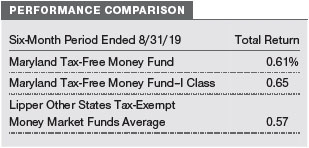
What factors influenced the fund’s performance?
After raising rates four times in 2018, the Federal Reserve cut its short-term lendingrate during the reporting period. The quarter-percentage-point rate cut in July dropped the federal funds target rate to a range of 2.00% to 2.25%. Other short-term interest rates also decreased.
In addition to the accommodative shift in monetary policy, supply constraints and solid demand contributed to the downward movement in short-term municipal interest rates during the period. Demand for muni money market securities from separately managed accounts and muni bond funds exerted pressure on supply as muni bond portfolios received historically high levels of cash inflows during the period.
Variable rate demand note (VRDN) yields averaged 1.50% since our last report six months ago, compared with a 1.57% average for the prior six months. Longer rates decreased 64 basis points (0.64 percentage point) over the most recent six months, with one-year maturities trading at 1.06% at the end of the reporting period. The fund’s seven-day simple SEC yield declined from 1.33% to 1.00% during the six-month period.
How is the fund positioned?
VRDNs, at 67% of net assets, represented the portfolio’s largest position in absolute terms at the end of the period, and we are overweight these very short-maturity (one to seven day) securities compared with our peer group average. We also had a significant position in fixed rate notes and bonds (23% of assets).
As a result of this strategy, the fund’s weighted average maturity was slightly longer than its peer group at the end of the reporting period. Our relative overweight to the front end of the money market yield curve provides the fund with the flexibility to respond to changes in interest rates or supply dynamics in the market.
Credit quality continues to play a significant part in our security selection. At the end of the period, our largest sector allocations were to health care and housing revenue debt as well as local general obligation (GO) securities.Some prominent positions in the portfolio includedMontgomery County,Johns Hopkins University, and theState of Maryland. (Please refer to the portfolio of investments for a complete list of holdings and the amount each represents in the portfolio.)
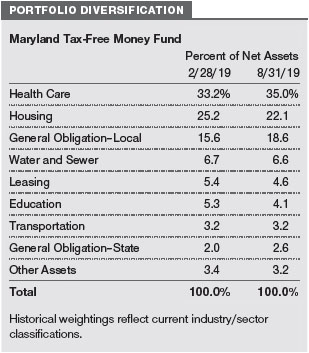
What is portfolio management’s outlook?
After our reporting period ended, the Fed announced another quarter-point rate cut at its September meeting, and we expect the central bank to maintain its accommodative posture for the remainder of 2019. We also believesupply and demand imbalances could continue to limit yield increases in the municipal money market.
As a result of these factors, we are pursuing a strategy that will allow the fund to quickly respond to a change in interest rate sentiment, an increase in issuance, or changing patterns of cash flows into or out of the muni money market. We believe the fund’s positioning in VRDNs and select longer-dated notes and bonds is appropriate in this environment.
As always, we remain committed to managing a high-quality, diversified portfolio focused on liquidity and stability of principal, which we deem of utmost importance to our shareholders.
MARYLAND SHORT-TERM TAX-FREE BOND FUND
INVESTMENT OBJECTIVE
The fund seeks to provide the highest level of income exempt from federal and Maryland state and local income taxes consistent with modest fluctuation in principal value.
FUND COMMENTARY
How did the fund perform in the past six months?
The Maryland Short-Term Tax-Free Bond Fund returned 1.85% for the six months ended August 31, 2019, performing in line with the Lipper Short Municipal Debt Funds Average. (Returns for I Class shares varied slightly,reflecting their different fee structure.Past performance cannot guarantee future results.)
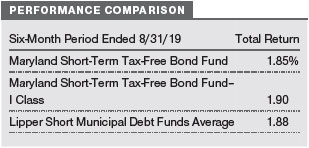
What factors influenced the fund’s performance?
Shorter-maturity municipal bonds produced positive returns for the six-monthperiod but underperformed the broader muni market as investors sought out higher-yielding, longer-maturity bonds.
The fund’s duration was modestly longer than the Bloomberg Barclays 1–3 Year Blend Index, and this interest rate positioning contributed positively to results as muni yields declined during the period. Our allocations on the yield curve were also beneficial. Specifically, our out-of-benchmark allocation to five-year maturities added value as they outperformed securities with shorter maturities. The fund’s weighted average maturity and duration were little changed over the last six months.
Our overweight in the revenue sector and underweight in prerefunded bonds also aided the fund’s results. At the security level, our holdings in the revenue-backed health care and special tax segments outperformed. The fund’s overall high credit quality weighed on relative returns as lower-quality national bonds performed very well in the most recent period, and there are limited opportunities for this style of investing in Maryland in our maturity range.
How is the fund positioned?
We continued to favor revenue bonds over GO debt in light of our long-held concerns that many municipalities will face challenges related to increased pension and health care liabilities. Within the revenue sector, the health care segment represents our largest position in absolute terms and relative to the benchmark, and we also maintained a large position in transportation bonds. These are segments where we believe we can rely on the strengths of our dedicated research team to find the best risk-adjusted yields.
While our preference for revenue bonds over GOs remains intact, it has been challenging to find opportunities in revenue debt over the past couple of years in the short- to intermediate-term municipal market. As a result, local GO bonds continued to be one of the fund’s largest allocations at the sector level at the end of the period.
However, we were able to reduce this position while increasing our allocation to higher-yielding revenue sectors such as the special tax and leasing segments. Notable purchases included theMaryland Stadium Authorityin the leasing subsector and theMaryland Department of Transportationin the special tax subsector. (Please refer to the fund’s portfolio of investments for a complete list of holdings and the amount each represents in the portfolio.)
The fund remains a high-quality portfolio, with more than half of its assets invested in AAA or AA securities.
What is portfolio management’s outlook?
Despite some high-profile credit challenges, we believe that municipal debt overall remains a high-quality market that offers good opportunities for long-term investors seeking tax-free income. The Tax Cuts and Jobs Act passed in December 2017 has altered not only issuance patterns, but also the economics of owning tax-free securities for some buyers. However, fundamentals for the asset class are generally sound.
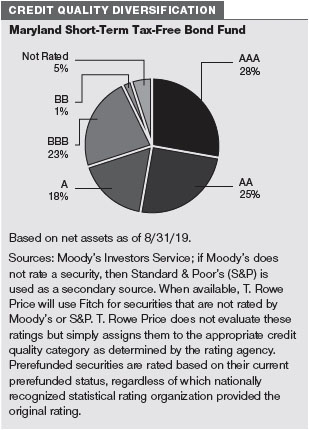
Given uncertainties about the economic outlook and the increased likelihood of further rate cuts by the Fed, muni and Treasury yields may remain low inthe coming months. The same global economic uncertainties, coupled with heightened geopolitical tensions, could spur demand for safe-haven assets such as municipal bonds.
Ultimately, we believe T. Rowe Price’s independent credit research is our greatest strength and will remain an asset for our investors as we navigate the current market environment. As always, we focus on finding attractively valued bonds issued by municipalities with good long-term fundamentals—an investment strategy that we believe will continue to serve our investors well.
MARYLAND TAX-FREE BOND FUND
INVESTMENT OBJECTIVE
The fund seeks to provide, consistent with prudent portfolio management, the highest level of income exempt from federal and Maryland state and local income taxes by investing primarily in investment-grade Maryland municipal bonds.
FUND COMMENTARY
How did the fund perform in the past six months?
The Maryland Tax-Free Bond Fund returned 5.86% for the six months ended August 31, 2019, outperforming the Lipper Maryland Municipal Debt Funds Average, which returned 5.42%. (Returns for I Class shares varied slightly,reflecting their different fee structure.Past performance cannot guarantee future results.)
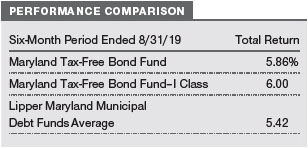
What factors influenced the fund’s performance?
The overall environment for municipal bonds was positive during the six-monthreporting period. The fund outpaced its peer group for the period as a result of yield curve positioning and our strategy of overweighting revenue bonds; however, a relatively large position in prerefunded bonds weighed on results. The portfolio’s returns for the period consisted of both dividends and an increase in the fund’s share price.
Our purchases of select Puerto Rico bonds over the past year were solid contributors to the fund’s outperformance versus its peers. After years of avoiding the commonwealth because of its fiscal troubles, we have slowly built positions in three Puerto Rico names—COFINA,PRASA, andPREPA—that performed well during the period. Income from U.S. territories such as Puerto Rico is tax-free in all 50 states. (Please refer to the fund’s portfolio of investments for a complete list of holdings and the amount each represents in the portfolio.)
COFINA bonds (which are backed by sales tax revenue) emerged from court restructuring early in 2019, and market participants gained comfort that enhanced legal protections and solid cash flow coverage would persist for this issuer into the future. PRASA bonds (issued by the water and sewer authority) rallied as the authority completed a restructuring of a subordinate loan with the federal government, while leaving existing senior lien bonds intact. The restructuring of PREPA (the electric utility) is ongoing, but we are constructive on the prospects for the resulting bonds, which will likely be backed by a surcharge on utility bills.
Although we have added some Puerto Rico-based issuers, we continued to avoid the commonwealth’s general obligation bonds. We have a negative view on the prospects for the GO debt as a result of the significant economic and fiscal challenges that Puerto Rico still faces.
We increased our emphasis on longer-maturity bonds over the period, and this position was a positive contributor to relative performance as securities with longer maturities outperformed. A little over half of the fund’s purchases had maturities of 20 years or longer. As a result, the fund’s average maturity lengthened from 16.5 years to 17.1 years during the period. However, the fund’s duration, which is a better indicator of interest rate risk, remained unchanged at 4.5 years.
While this position was additive to relative returns, we took steps to mitigate some of our interest rate risk later in the period. We sold Treasury futures as a hedge against a potential increase in interest rates, and this weighed on our results near the end of the period. Going forward, we expect to maintain a more or less overall neutral interest rate risk profile as the market debates the extent of future Fed rate cuts.
How is the fund positioned?
With municipal yields at or near all-time lows, it has been difficult to generate much enthusiasm about investing in current market conditions. However, we believe our fundamental, research-driven investment process will continue to produce solid long-term returns for our shareholders over full credit and interest rate cycles.
Health care, including life care and hospitals, remained our largest sector allocation. The segment, which provides a little extra yield compared with most other sectors, represented 27.2% of the portfolio’s assets at period-end, little changed from our previous report.
While we still have lingering concerns about state and local governments’ ability to finance pensions and retiree health care benefits nationally, there are a number of strong local general obligation credits in Maryland that we added to during the reporting period. We increased our significant position inAnne Arundel CountyGO debt as we believe these high-quality securities offer an attractive valuation.
In the revenue sector, our purchases were mostly in the transportation segment. We addedAir Cargo Obligated Group (AFCO Airport Real Estate Group)bonds andPassenger Facility Charge (BWI)bonds as well as Maryland Economic Development (MEDCO) bonds issued for capital improvements attheSea Girt Marine Terminal, a containerized cargo-handling facility at the Port of Baltimore. While these securities have their own unique attributes and risks, they also carry premium yields that should provide steady excess income to the fund over time.
Maryland’s credit rating was unchanged during the period. As of August 31, 2019, the state’s GO bonds were rated Aaa by Moody’s Investors Service and AAA by S&P Global Ratings and Fitch Ratings. All three rating agencies maintain stable outlooks. The state’s fiscal year 2019 general fund revenues exceeded estimates, and income tax revenue grew 10%, an increase that is partly attributable to 2017’s federal tax reform.
Maryland has a long history of responsible stewardship and prudent financial management, but, unfavorably, Maryland’s pension system was only funded at 71% on an actuarial basis, according to the most recent data. Maryland’s practice of not fully funding its actuarial required contributions has led to arise in its unfunded pension liability. As a result, Maryland faces heavy unfunded liabilities for its pension plans compared with other AAA rated states. Various modifications to benefits under these programs as well as higher employee contributions have been imposed to reduce liabilities and improve funding, and we are closely monitoring Maryland’s progress in this regard.
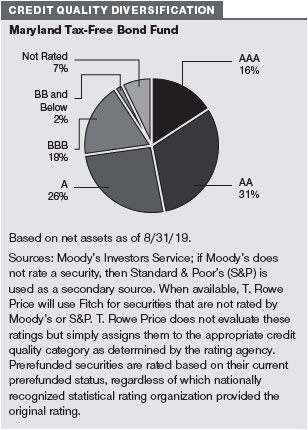
What is portfolio management’s outlook?
Despite some high-profile credit challenges, we believe that municipal debt overall remains a high-quality market that offers good opportunities for long-term investors seeking tax-freeincome. The Tax Cuts and Jobs Act passed in December 2017 has altered not only issuance patterns, but also the economics of owning tax-free securities for some buyers. However, fundamentals for the asset class are generally sound.
Given uncertainties about the economic outlook and the increased likelihood of further rate cuts by the Fed, muni and Treasury yields may remain low in the coming months. The same global economic uncertainties, coupled with heightened geopolitical tensions, could spur demand for safe-haven assets such as municipal bonds.
Ultimately, we believe T. Rowe Price��s independent credit research is our greatest strength and will remain an asset for our investors as we navigate the current market environment. As always, we focus on finding attractively valued bonds issued by municipalities with good long-term fundamentals—an investment strategy that we believe will continue to serve our investors well.
The views expressed reflect the opinions of T. Rowe Price as of the date of this report and are subject to change based on changes in market, economic, or other conditions. These views are not intended to be a forecast of future events and are no guarantee of future results.
RISKS OF INVESTING IN A RETAIL MONEY MARKET FUND
You could lose money by investing in the Fund. Although the Fund seeks to preserve the value of your investment at $1.00 per share, it cannot guarantee it will do so. The Fund may impose a fee upon the sale of your shares or may temporarily suspend your ability to sell shares if the Fund’s liquidity falls below required minimums because of market conditions or other factors. An investment in the Fund is not insured or guaranteed by the Federal Deposit Insurance Corporation or any other government agency. The Fund’s sponsor has no legal obligation to provide financial support to the Fund, and you should not expect that the sponsor will provide financial support to the Fund at any time.
RISKS OF INVESTING IN FIXED INCOME SECURITIES
Bonds are subject to interest rate risk (the decline in bond prices that usually accompanies a rise in interest rates) and credit risk (the chance that any fund holding could have its credit rating downgraded or that a bond issuer will default by failing to make timely payments of interest or principal), potentially reducing the fund’s income level and share price. The fund is less diversified than one investing nationally. Some income may be subject to state and local taxes and the federal alternative minimum tax.
BENCHMARK INFORMATION
Note: Bloomberg Index Services Ltd. Copyright © 2019, Bloomberg Index Services Ltd. Used with permission.
GROWTH OF $10,000
This chart shows the value of a hypothetical $10,000 investment in the fund over the past 10 fiscal year periods or since inception (for funds lacking 10-year records). The result is compared with benchmarks, which include a broad-based market index and may also include a peer group average or index. Market indexes do not include expenses, which are deducted from fund returns as well as mutual fund averages and indexes.
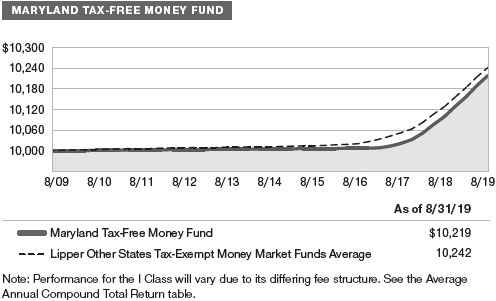
AVERAGE ANNUAL COMPOUND TOTAL RETURN
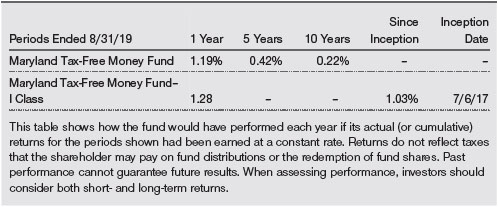
GROWTH OF $10,000
This chart shows the value of a hypothetical $10,000 investment in the fund over the past 10 fiscal year periods or since inception (for funds lacking 10-year records). The result is compared with benchmarks, which include a broad-based market index and may also include a peer group average or index. Market indexes do not include expenses, which are deducted from fund returns as well as mutual fund averages and indexes.
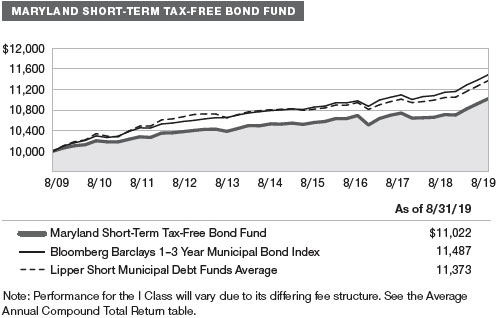
AVERAGE ANNUAL COMPOUND TOTAL RETURN
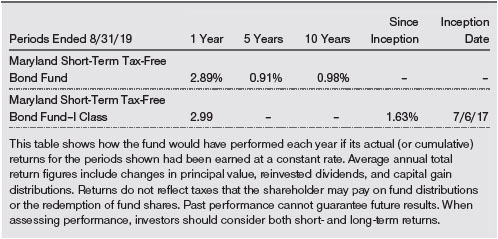
GROWTH OF $10,000
This chart shows the value of a hypothetical $10,000 investment in the fund over the past 10 fiscal year periods or since inception (for funds lacking 10-year records). The result is compared with benchmarks, which include a broad-based market index and may also include a peer group average or index. Market indexes do not include expenses, which are deducted from fund returns as well as mutual fund averages and indexes.
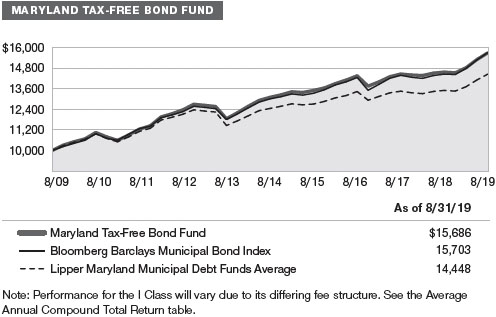
AVERAGE ANNUAL COMPOUND TOTAL RETURN
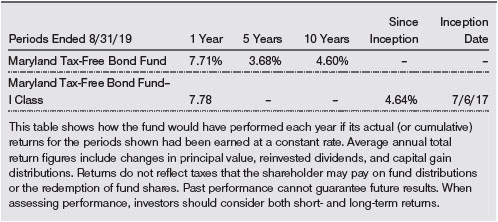
EXPENSE RATIOS
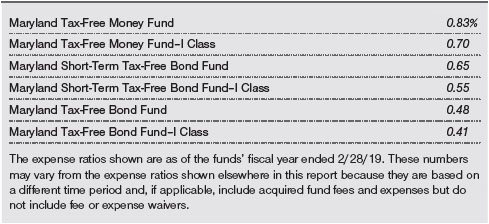
FUND EXPENSE EXAMPLE
As a mutual fund shareholder, you may incur two types of costs: (1) transaction costs, such as redemption fees or sales loads, and (2) ongoing costs, including management fees, distribution and service (12b-1) fees, and other fund expenses. The following example is intended to help you understand your ongoing costs (in dollars) of investing in each fund and to compare these costs with the ongoing costs of investing in other mutual funds. The example is based on an investment of $1,000 invested at the beginning of the most recent six-month period and held for the entire period.
Please note that each fund has two share classes: The original share class (Investor Class) charges no distribution and service (12b-1) fee, and the I Class shares are also available to institutionally oriented clients and impose no 12b-1 or administrative fee payment. Each share class is presented separately in the table.
Actual Expenses
The first line of the following table (Actual) provides information about actual account values and expenses based on each fund’s actual returns. You may use the information on this line, together with your account balance, to estimate the expenses that you paid over the period. Simply divide your account value by $1,000 (for example, an $8,600 account value divided by $1,000 = 8.6), then multiply the result by the number on the first line under the heading “Expenses Paid During Period” to estimate the expenses you paid on your account during this period.
Hypothetical Example for Comparison Purposes
The information on the second line of the table (Hypothetical) is based on hypothetical account values and expenses derived from each fund’s actual expense ratio and an assumed 5% per year rate of return before expenses (not the fund’s actual return). You may compare the ongoing costs of investing in each fund with other funds by contrasting this 5% hypothetical example and the 5% hypothetical examples that appear in the shareholder reports of the other funds. The hypothetical account values and expenses may not be used to estimate the actual ending account balance or expenses you paid for the period.
Note:T. Rowe Price charges an annual account service fee of $20, generally for accounts with less than $10,000. The fee is waived for any investor whose T. Rowe Price mutual fund accounts total $50,000 or more; accounts electing to receive electronic delivery of account statements, transaction confirmations, prospectuses, and shareholder reports; or accounts of an investor who is a T. Rowe Price Personal Services or Enhanced Personal Services client (enrollment in these programs generally requires T. Rowe Price assets of at least $250,000). This fee is not included in the accompanying table. If you are subject to the fee, keep it in mind when you are estimating the ongoing expenses of investing in the fund and when comparing the expenses of each fund with other funds.
You should also be aware that the expenses shown in the table highlight only your ongoing costs and do not reflect any transaction costs, such as redemption fees or sales loads. Therefore, the second line of the table is useful in comparing ongoing costs only and will not help you determine the relative total costs of owning different funds. To the extent a fund charges transaction costs, however, the total cost of owning that fund is higher.
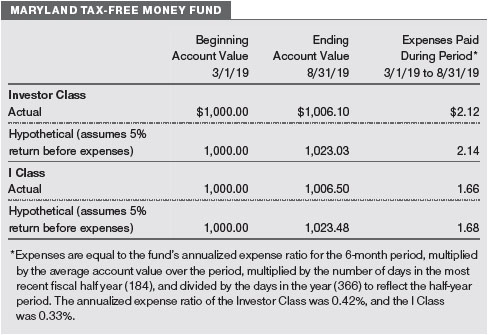
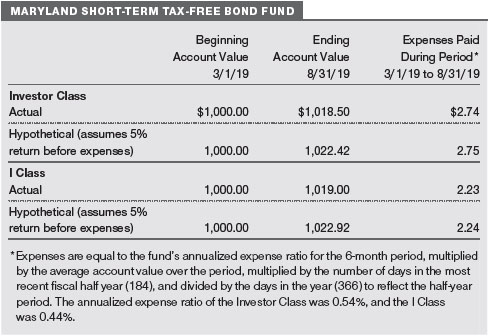
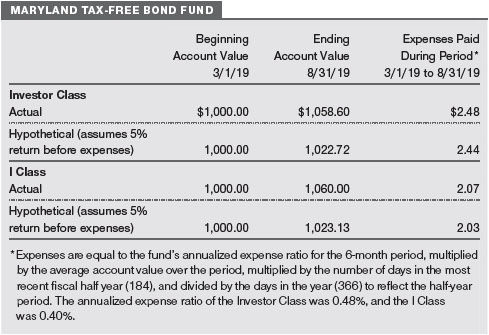
QUARTER-END RETURNS
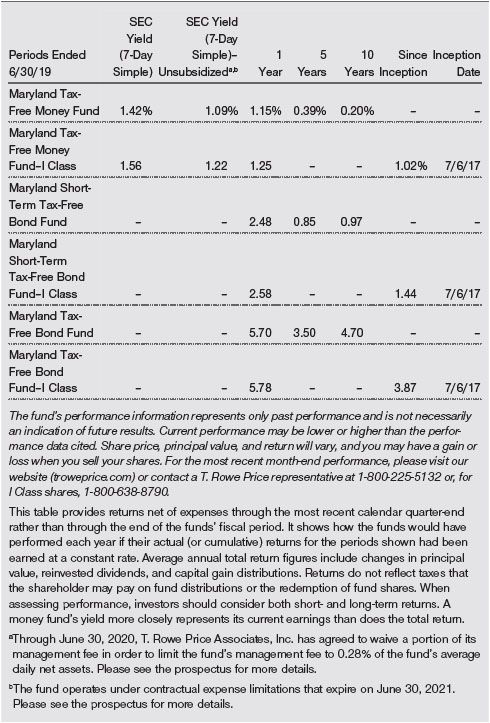
Unaudited
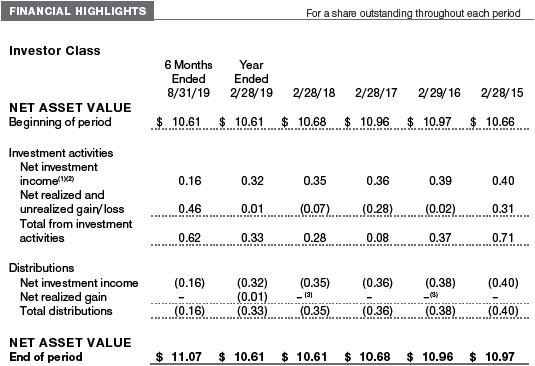
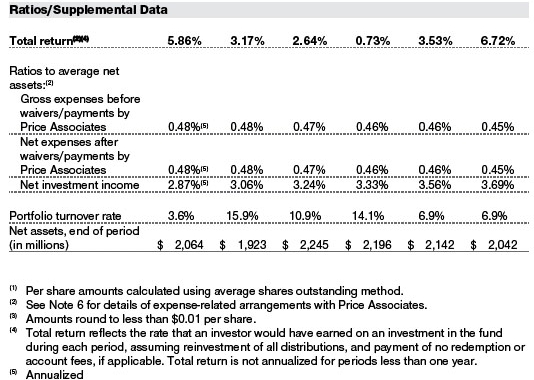
The accompanying notes are an integral part of these financial statements.
Unaudited
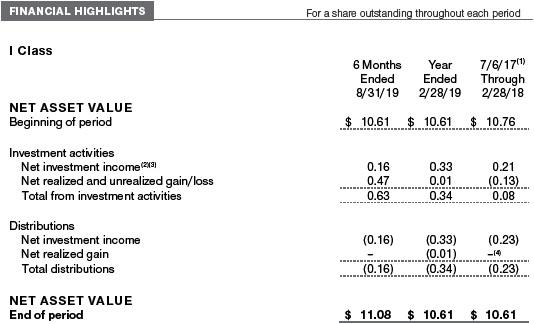
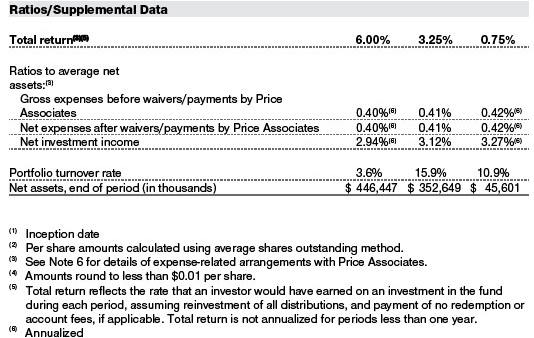
The accompanying notes are an integral part of these financial statements.
Unaudited
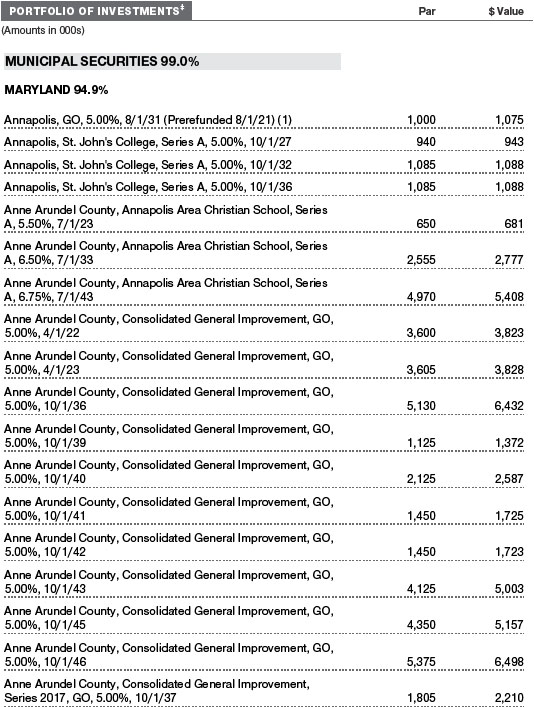
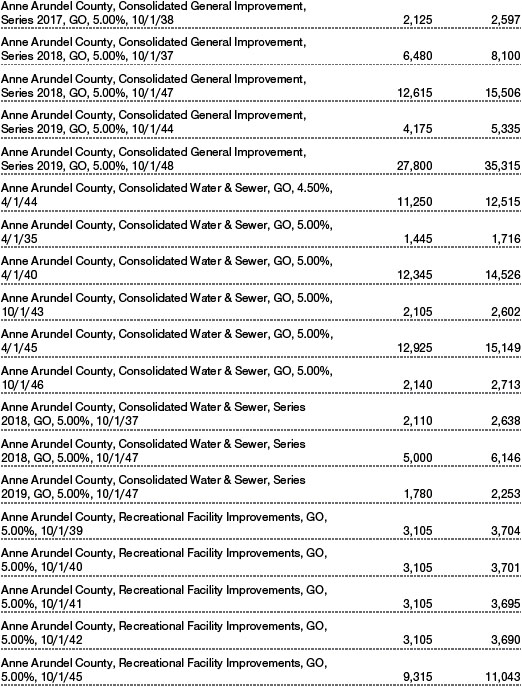
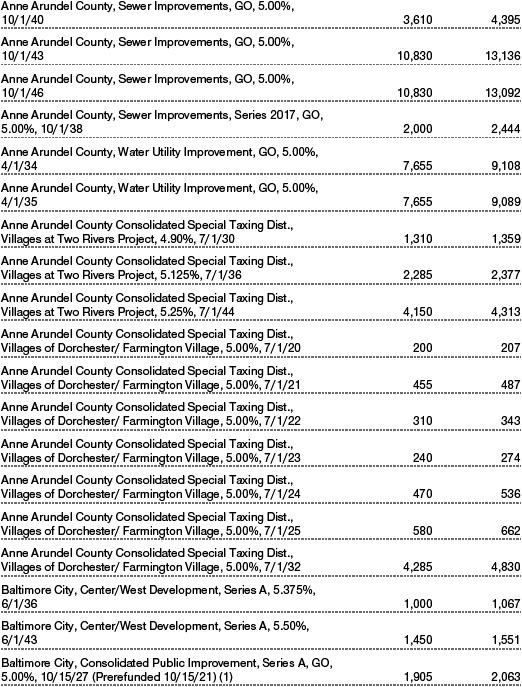
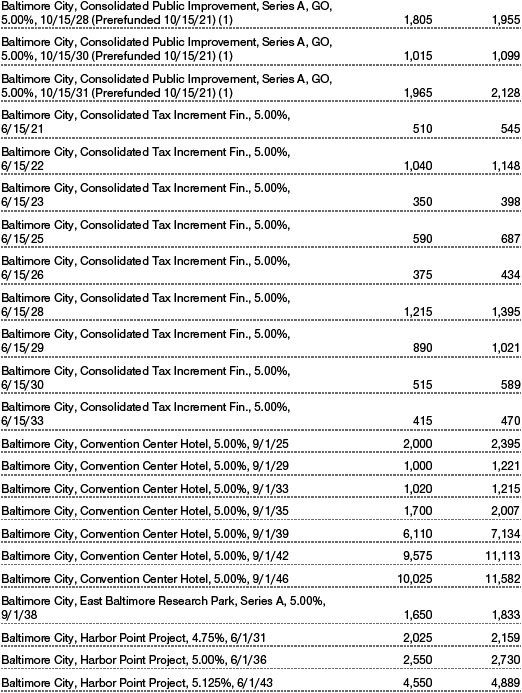
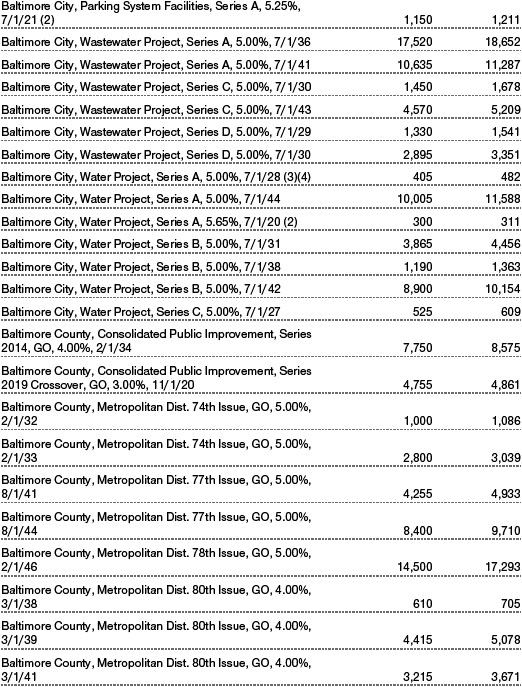
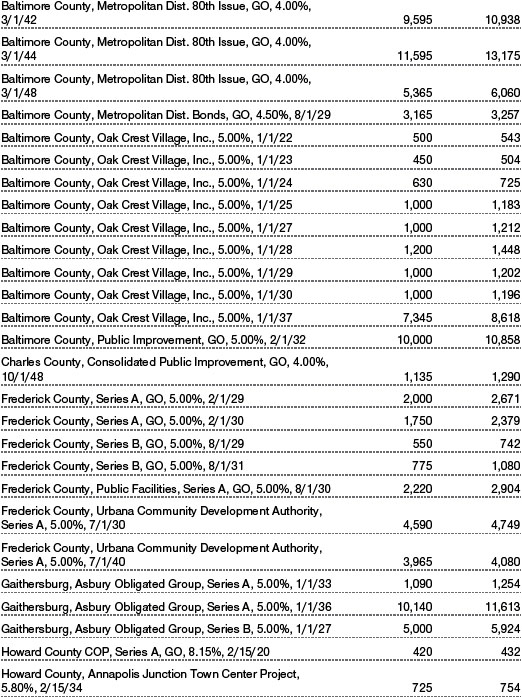
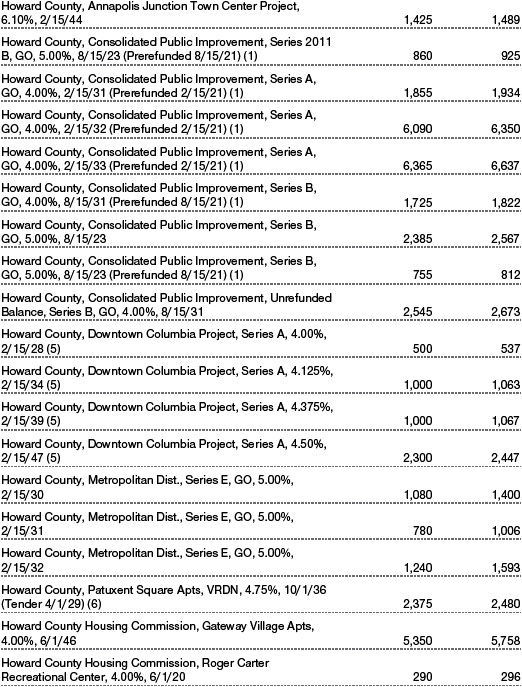
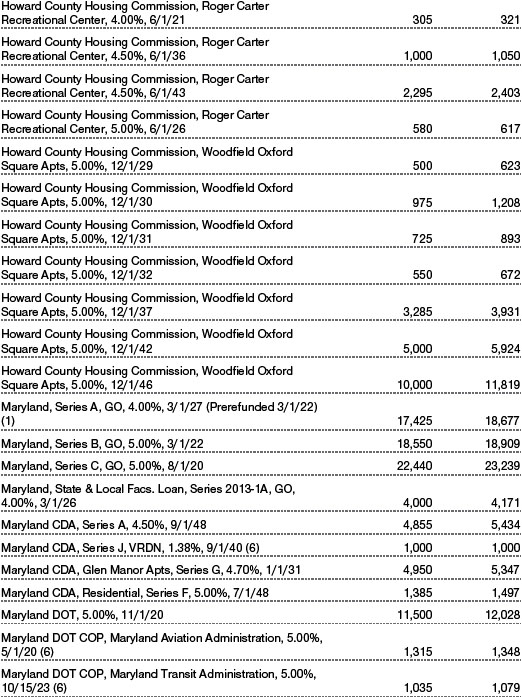
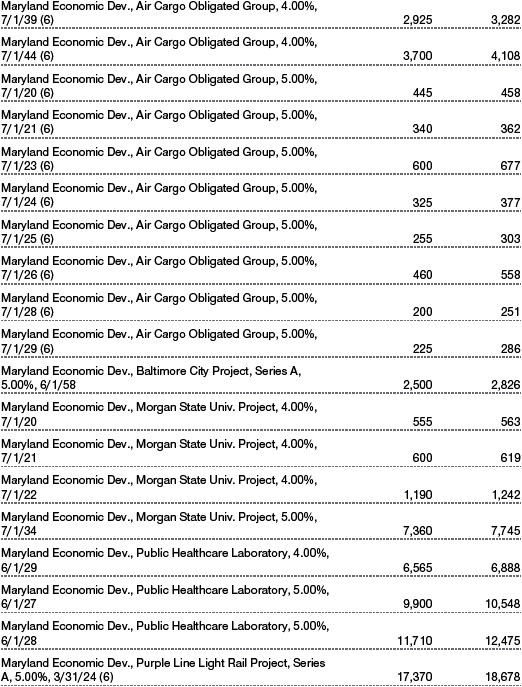
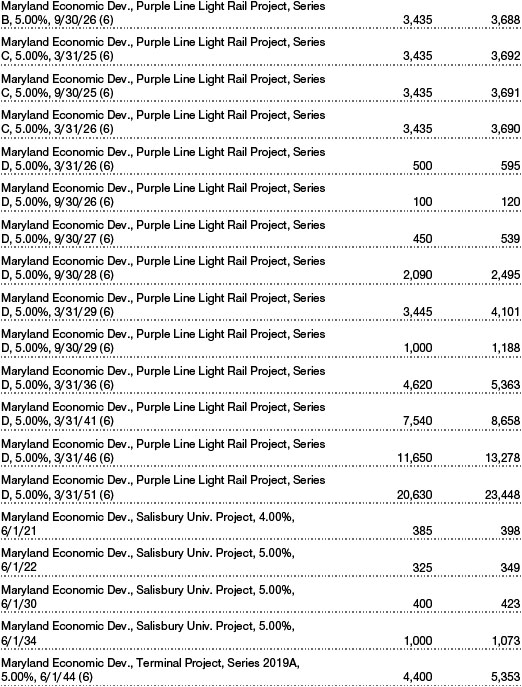
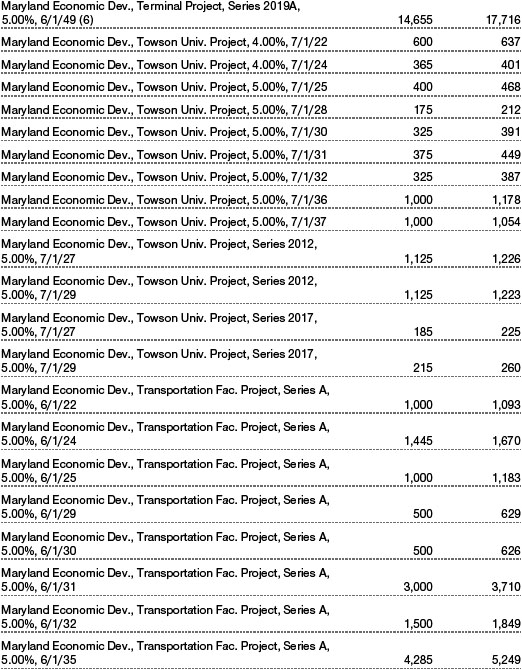
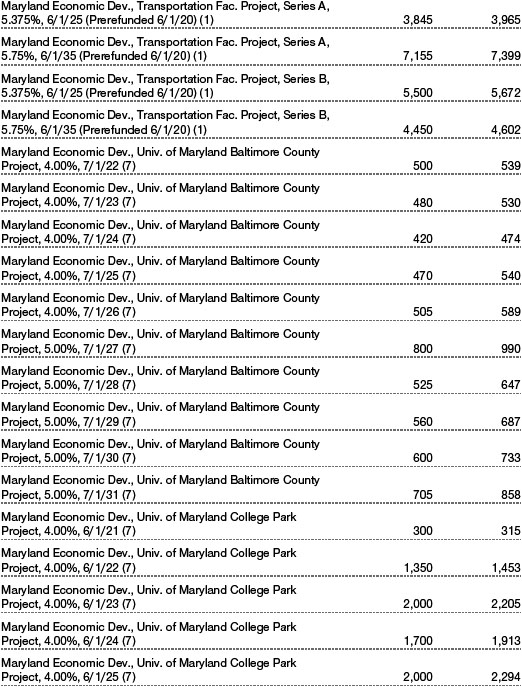
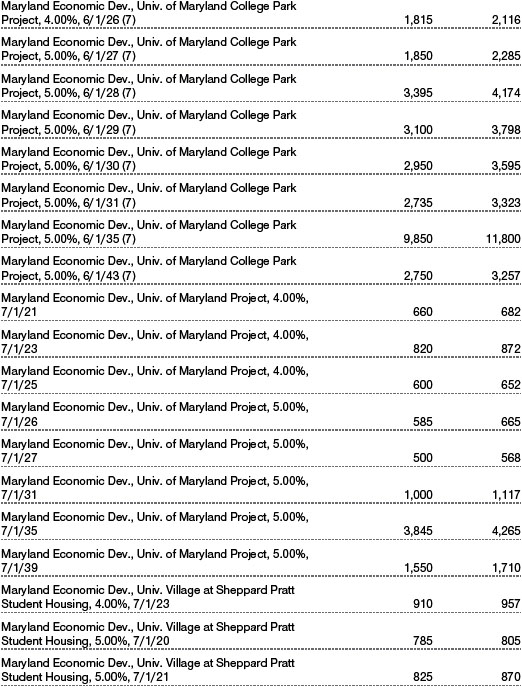
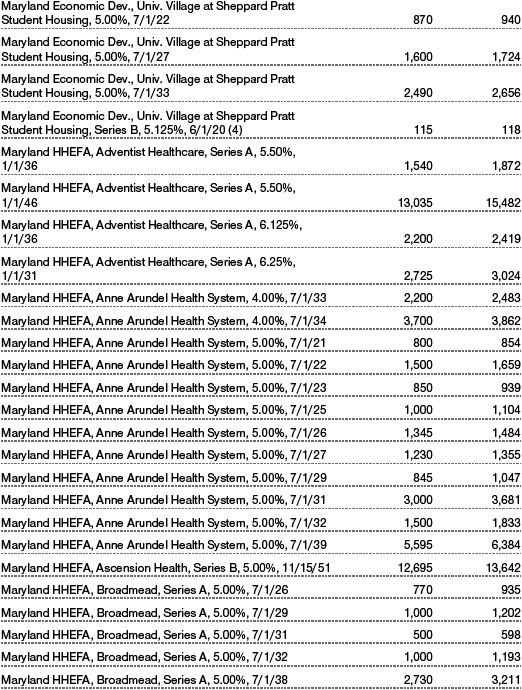
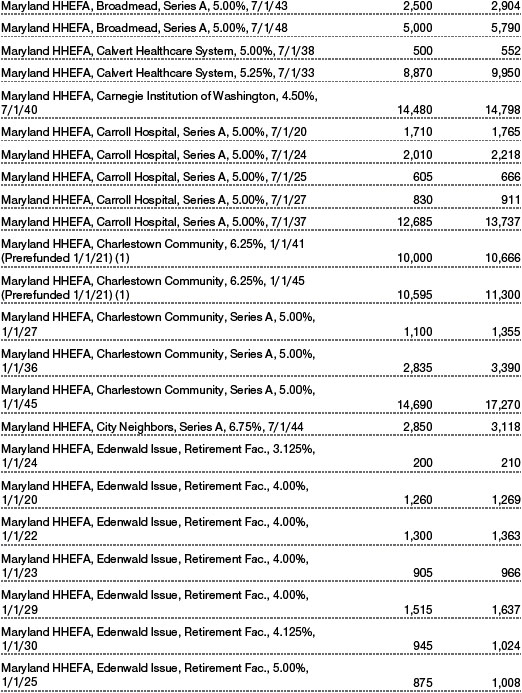
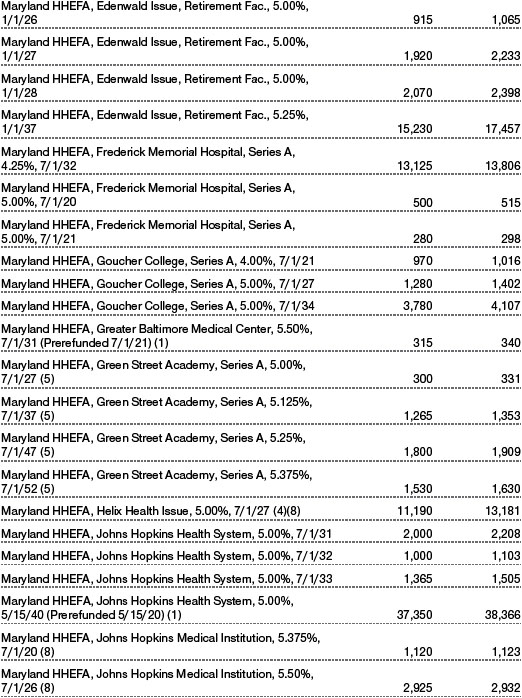
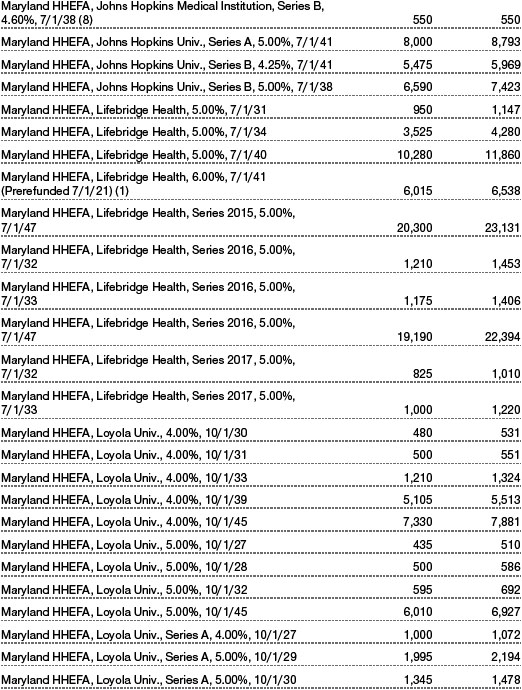
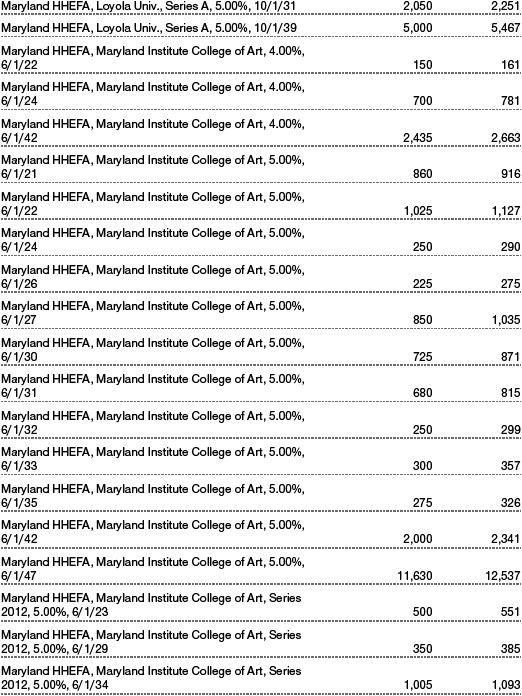
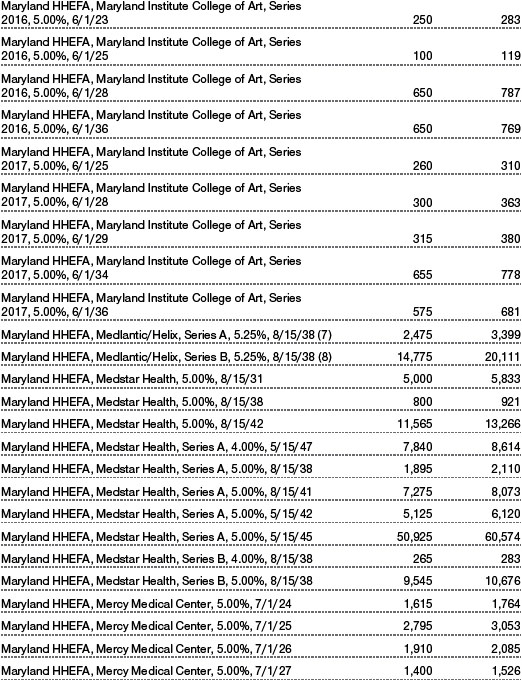
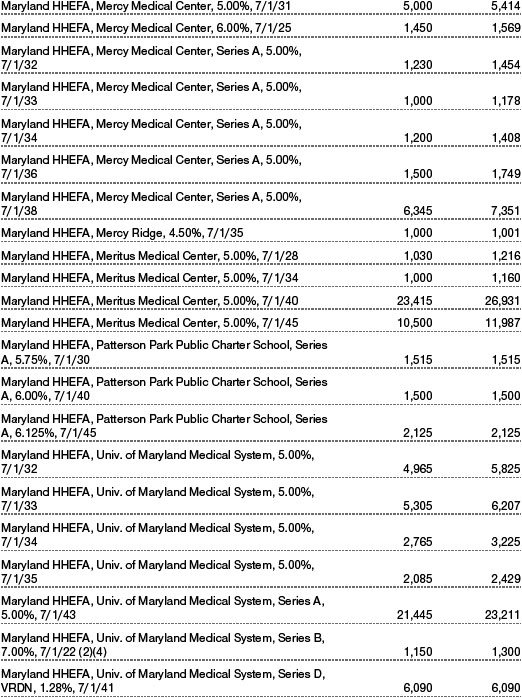
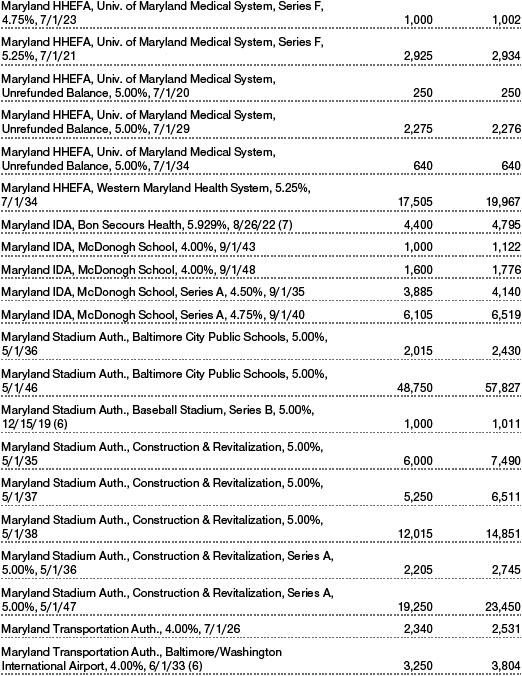
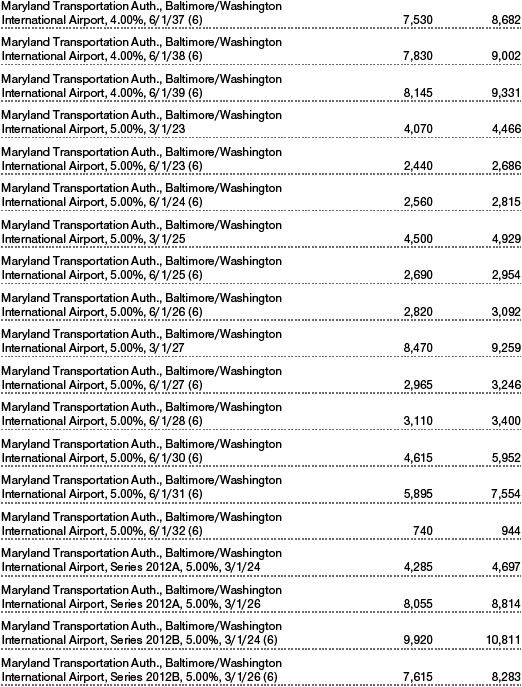
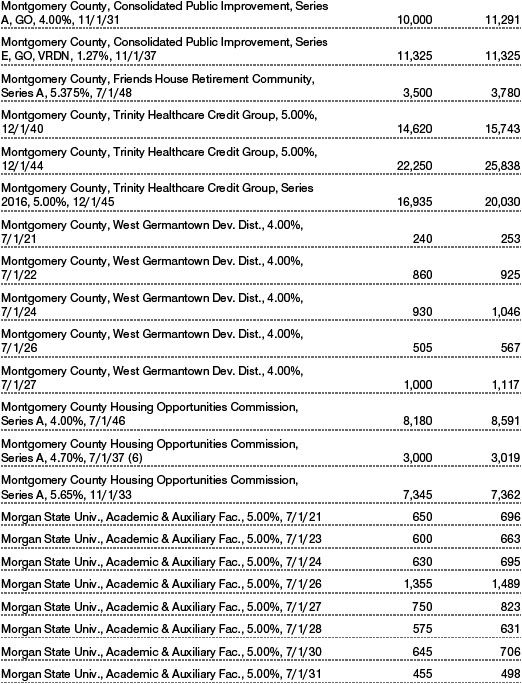
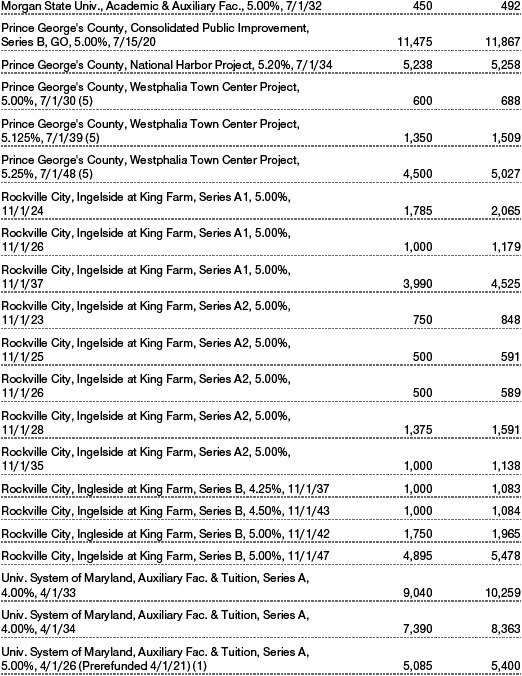
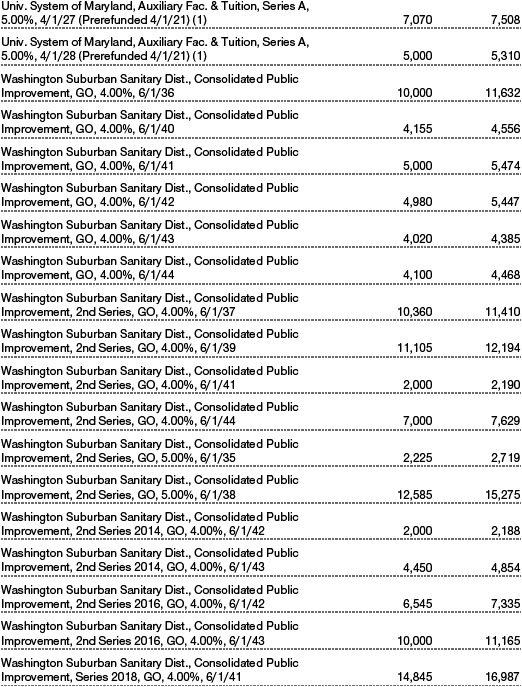
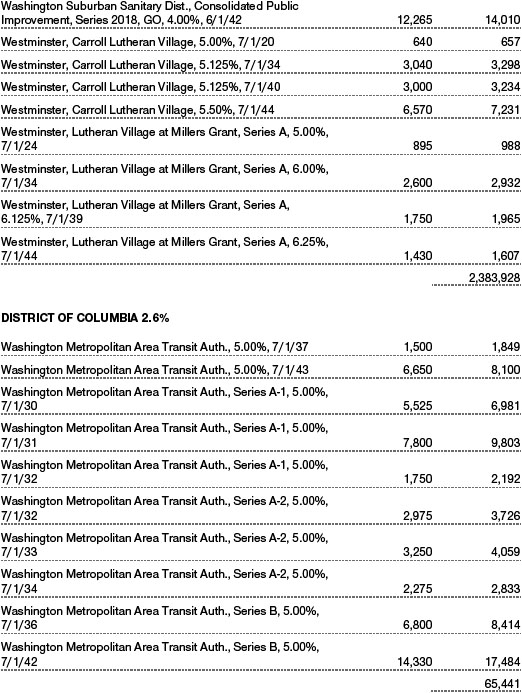
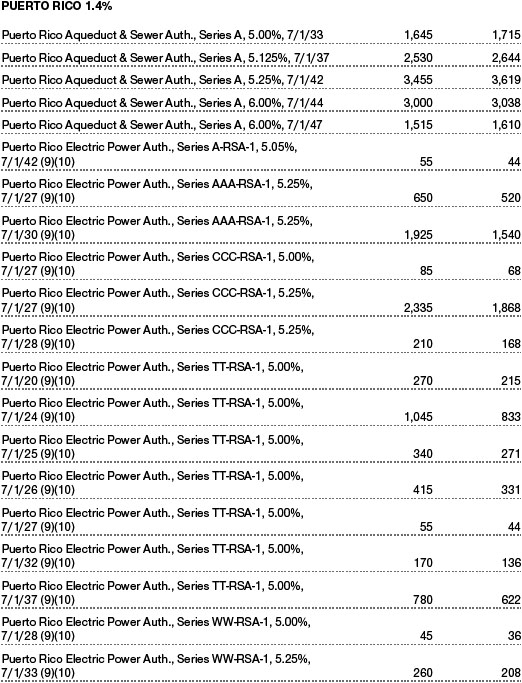
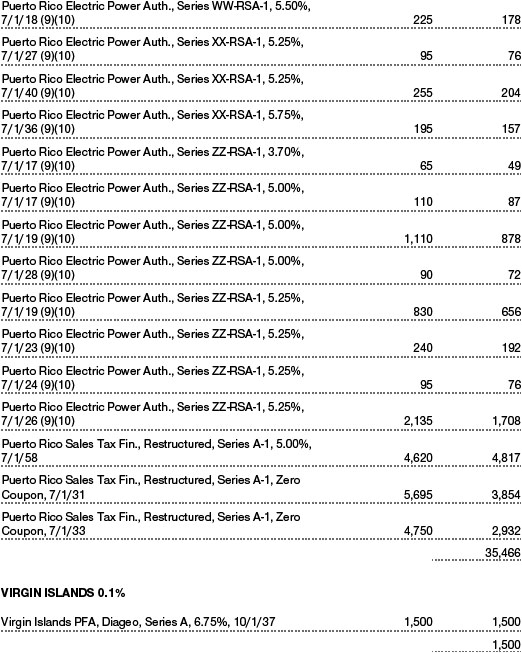
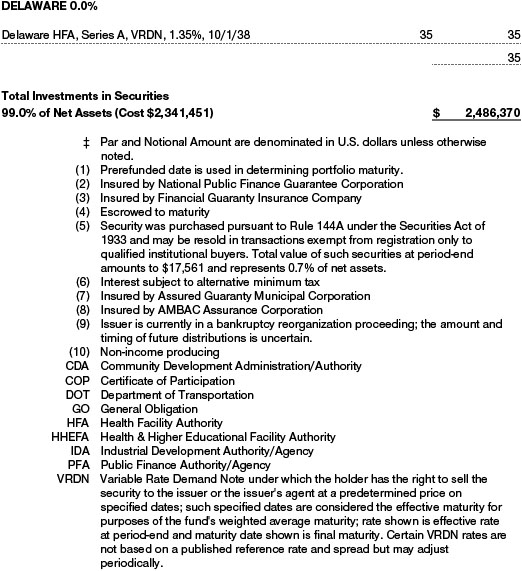
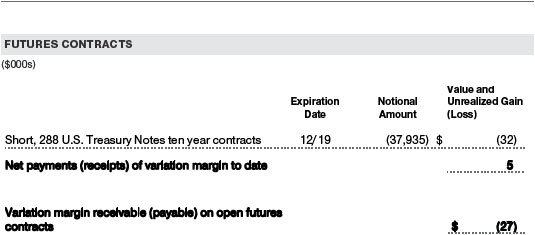
The accompanying notes are an integral part of these financial statements.
Unaudited
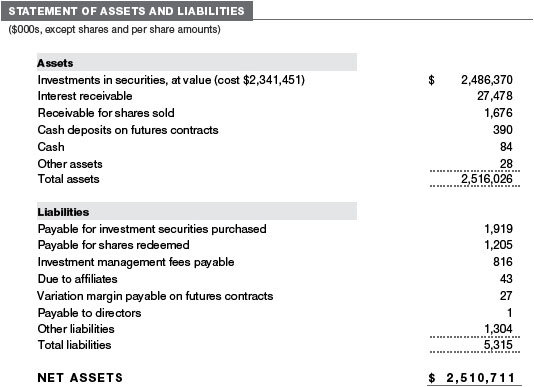
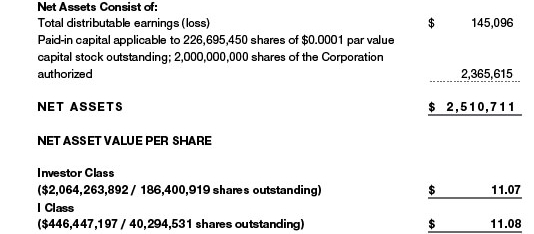
The accompanying notes are an integral part of these financial statements.
Unaudited
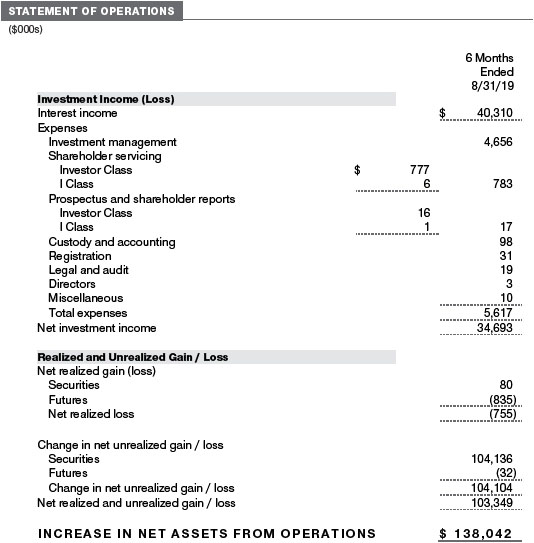
The accompanying notes are an integral part of these financial statements.
Unaudited
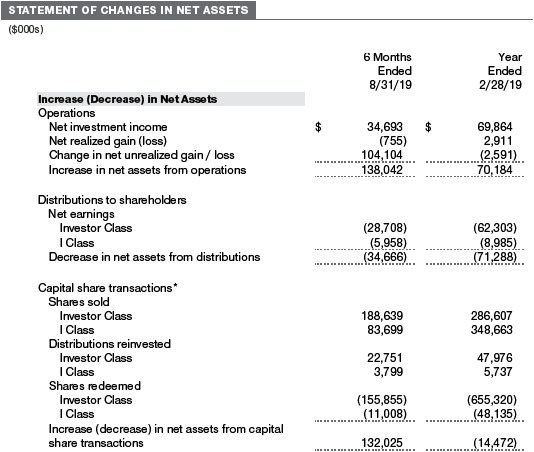
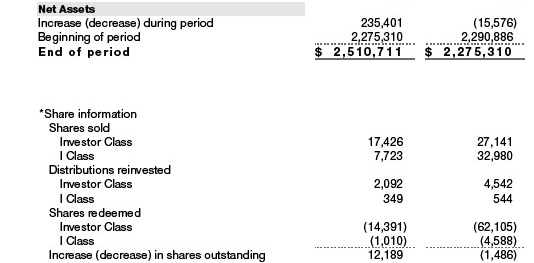
The accompanying notes are an integral part of these financial statements.
Unaudited
| NOTES TO FINANCIAL STATEMENTS |
T. Rowe Price State Tax-Free Funds, Inc. (the corporation) is registered under the Investment Company Act of 1940 (the 1940 Act). The Maryland Tax-Free Bond Fund (the fund) is a nondiversified, open-end management investment company established by the corporation. The fund seeks to provide, consistent with prudent portfolio management, the highest level of income exempt from federal and Maryland state and local income taxes by investing primarily in investment-grade Maryland municipal bonds. The fund has two classes of shares: the Maryland Tax-Free Bond Fund (Investor Class) and the Maryland Tax-Free Bond Fund–I Class (I Class). I Class shares require a $1 million initial investment minimum, although the minimum generally is waived for retirement plans, financial intermediaries, and certain other accounts. Each class has exclusive voting rights on matters related solely to that class; separate voting rights on matters that relate to both classes; and, in all other respects, the same rights and obligations as the other class.
NOTE 1 - SIGNIFICANT ACCOUNTING POLICIES
Basis of PreparationThe fund is an investment company and follows accounting and reporting guidance in the Financial Accounting Standards Board (FASB)Accounting Standards CodificationTopic 946 (ASC 946). The accompanying financial statements were prepared in accordance with accounting principles generally accepted in the United States of America (GAAP), including, but not limited to, ASC 946. GAAP requires the use of estimates made by management. Management believes that estimates and valuations are appropriate; however, actual results may differ from those estimates, and the valuations reflected in the accompanying financial statements may differ from the value ultimately realized upon sale or maturity. Certain prior year amounts in the accompanying financial statements and financial highlights have been restated to conform to current year presentation.
Investment Transactions, Investment Income, and DistributionsInvestment transactions are accounted for on the trade date basis. Income and expenses are recorded on the accrual basis. Realized gains and losses are reported on the identified cost basis. Premiums and discounts on debt securities are amortized for financial reporting purposes. Income tax-related interest and penalties, if incurred, are recorded as income tax expense. Distributions to shareholders are recorded on the ex-dividend date.Income distributions are declared by each class daily and paid monthly. A capital gain distribution may also be declared and paid by the fund annually.
Class AccountingShareholder servicing, prospectus, and shareholder report expenses incurred by each class are charged directly to the class to which they relate. Expenses common to both classes and investment income are allocated to the classes based upon the relative daily net assets of each class’s settled shares; realized and unrealized gains and losses are allocated based upon the relative daily net assets of each class’s outstanding shares.
New Accounting GuidanceIn March 2017, the FASB issued amended guidance to shorten the amortization period for certain callable debt securities held at a premium. The guidance is effective for fiscal years and interim periods beginning after December 15, 2018. Adoption will have no effect on the fund’s net assets or results of operations.
IndemnificationIn the normal course of business, the fund may provide indemnification in connection with its officers and directors, service providers, and/or private company investments. The fund’s maximum exposure under these arrangements is unknown; however, the risk of material loss is currently considered to be remote.
NOTE 2 - VALUATION
The fund’s financial instruments are valued and each class’s net asset value (NAV) per share is computed at the close of the New York Stock Exchange (NYSE), normally 4 p.m. ET, each day the NYSE is open for business. However, the NAV per share may be calculated at a time other than the normal close of the NYSE if trading on the NYSE is restricted, if the NYSE closes earlier, or as may be permitted by the SEC.
Fair ValueThe fund’s financial instruments are reported at fair value, which GAAP defines as the price that would be received to sell an asset or paid to transfer a liability in an orderly transaction between market participants at the measurement date. The T. Rowe Price Valuation Committee (the Valuation Committee) is an internal committee that has been delegated certain responsibilities by the fund’s Board of Directors (the Board) to ensure that financial instruments are appropriately priced at fair value in accordance with GAAP and the 1940 Act. Subject to oversight by the Board, the Valuation Committee develops and oversees pricing-related policies and procedures and approves all fair value determinations. Specifically, the Valuation Committee establishes procedures to value securities; determines pricing techniques, sources, and persons eligible to effect fair value pricing actions; oversees the selection, services, and performance of pricing vendors; oversees valuation-related business continuity practices; and provides guidance on internal controls and valuation-related matters. The Valuation Committee reports to the Board and has representation from legal, portfolio management and trading, operations, risk management, and the fund’s treasurer.
Various valuation techniques and inputs are used to determine the fair value of financial instruments. GAAP establishes the following fair value hierarchy that categorizes the inputs used to measure fair value:
Level 1 – quoted prices (unadjusted) in active markets for identical financial instruments that the fund can access at the reporting date
Level 2 – inputs other than Level 1 quoted prices that are observable, either directly or indirectly (including, but not limited to, quoted prices for similar financial instruments in active markets, quoted prices for identical or similar financial instruments in inactive markets, interest rates and yield curves, implied volatilities, and credit spreads)
Level 3 – unobservable inputs
Observable inputs are developed using market data, such as publicly available information about actual events or transactions, and reflect the assumptions that market participants would use to price the financial instrument. Unobservable inputs are those for which market data are not available and are developed using the best information available about the assumptions that market participants would use to price the financial instrument. GAAP requires valuation techniques to maximize the use of relevant observable inputs and minimize the use of unobservable inputs. When multiple inputs are used to derive fair value, the financial instrument is assigned to the level within the fair value hierarchy based on the lowest-level input that is significant to the fair value of the financial instrument. Input levels are not necessarily an indication of the risk or liquidity associated with financial instruments at that level but rather the degree of judgment used in determining those values.
Valuation TechniquesDebt securities generally are traded in the over-the-counter (OTC) market and are valued at prices furnished by dealers who make markets in such securities or by an independent pricing service, which considers the yield or price of bonds of comparable quality, coupon, maturity, and type, as well as prices quoted by dealers who make markets in such securities. Generally, debt securities are categorized in Level 2 of the fair value hierarchy; however, to the extent the valuations include significant unobservable inputs, the securities would be categorized in Level 3.
Financial futures contracts are valued at closing settlement prices and are categorized in Level 1 of the fair value hierarchy. Assets and liabilities other than financial instruments, including short-term receivables and payables, are carried at cost, or estimated realizable value, if less, which approximates fair value.
Thinly traded financial instruments and those for which the above valuation procedures are inappropriate or are deemed not to reflect fair value are stated at fair value as determined in good faith by the Valuation Committee. The objective of any fair value pricing determination is to arrive at a price that could reasonably be expected from a current sale. Financial instruments fair valued by the Valuation Committee are primarily private placements, restricted securities, warrants, rights, and other securities that are not publicly traded.
Subject to oversight by the Board, the Valuation Committee regularly makes good faith judgments to establish and adjust the fair valuations of certain securities as events occur and circumstances warrant. For instance, in determining the fair value of troubled or thinly traded debt instruments, the Valuation Committee considers a variety of factors, which may include, but are not limited to, the issuer’s business prospects, its financial standing and performance, recent investment transactions in the issuer, strategic events affecting the company, market liquidity for the issuer, and general economic conditions and events. In consultation with the investment and pricing teams, the Valuation Committee will determine an appropriate valuation technique based on available information, which may include both observable and unobservable inputs. The Valuation Committee typically will afford greatest weight to actual prices in arm’s length transactions, to the extent they represent orderly transactions between market participants, transaction information can be reliably obtained, and prices are deemed representative of fair value. However, the Valuation Committee may also consider other valuation methods such as a discount or premium from market value of a similar, freely traded security of the same issuer; discounted cash flows; yield to maturity; or some combination. Fair value determinations are reviewed on a regular basis and updated as information becomes available, including actual purchase and sale transactions of the issue. Because any fair value determination involves a significant amount of judgment, there is a degree of subjectivity inherent in such pricing decisions, and fair value prices determined by the Valuation Committee could differ from those of other market participants. Depending on the relative significance of unobservable inputs, including the valuation technique(s) used, fair valued securities may be categorized in Level 2 or 3 of the fair value hierarchy.
Valuation InputsThe following table summarizes the fund’s financial instruments, based on the inputs used to determine their fair values on August 31, 2019 (for further detail by category, please refer to the accompanying Portfolio of Investments):

NOTE 3 - DERIVATIVE INSTRUMENTS
During the six months ended August 31, 2019, the fund invested in derivative instruments. As defined by GAAP, a derivative is a financial instrument whose value is derived from an underlying security price, foreign exchange rate, interest rate, index of prices or rates, or other variable; it requires little or no initial investment and permits or requires net settlement. The fund invests in derivatives only if the expected risks and rewards are consistent with its investment objectives, policies, and overall risk profile, as described in its prospectus and Statement of Additional Information. The fund may use derivatives for a variety of purposes, such as seeking to hedge against declines in principal value, increase yield, invest in an asset with greater efficiency and at a lower cost than is possible through direct investment, to enhance return, or to adjust portfolio duration and credit exposure. The risks associated with the use of derivatives are different from, and potentially much greater than, the risks associated with investing directly in the instruments on which the derivatives are based. The fund at all times maintains sufficient cash reserves, liquid assets, or other SEC-permitted asset types to cover its settlement obligations under open derivative contracts.
The fund values its derivatives at fair value and recognizes changes in fair value currently in its results of operations. Accordingly, the fund does not follow hedge accounting, even for derivatives employed as economic hedges. Generally, the fund accounts for its derivatives on a gross basis. It does not offset the fair value of derivative liabilities against the fair value of derivative assets on its financial statements, nor does it offset the fair value of derivative instruments against the right to reclaim or obligation to return collateral. As of August 31, 2019, the fund held interest rate futures with cumulative unrealized loss of $32,000; the value reflected on the accompanying Statement of Assets and Liabilities is the related unsettled variation margin.
Additionally, during the six months ended August 31, 2019, the fund recognized $835,000 of realized loss on Futures and a $(32,000) change in unrealized gain/loss on Futures related to its investments in interest rate derivatives; such amounts are included on the accompanying Statement of Operations.
Counterparty Risk and CollateralThe fund invests in exchange-traded or centrally cleared derivative contracts, such as futures, exchange-traded options, and centrally cleared swaps. Counterparty risk on such derivatives is minimal because the clearinghouse provides protection against counterparty defaults. For futures and centrally cleared swaps, the fund is required to deposit collateral in an amount specified by the clearinghouse and the clearing firm (margin requirement), and the margin requirement must be maintained over the life of the contract. Each clearinghouse and clearing firm, in its sole discretion, may adjust the margin requirements applicable to the fund.
Collateral may be in the form of cash or debt securities issued by the U.S. government or related agencies. Cash posted by the fund is reflected as cash deposits in the accompanying financial statements and generally is restricted from withdrawal by the fund; securities posted by the fund are so noted in the accompanying Portfolio of Investments; both remain in the fund’s assets. While typically not sold in the same manner as equity or fixed income securities, exchange-traded or centrally cleared derivatives may be closed out only on the exchange or clearinghouse where the contracts were traded. This ability is subject to the liquidity of underlying positions. As of August 31, 2019, cash of $390,000 had been posted by the fund for exchange-traded and/or centrally cleared derivatives.
Futures ContractsThe fund is subject to interest rate risk in the normal course of pursuing its investment objectives and uses futures contracts to help manage such risk. The fund may enter into futures contracts to manage exposure to interest rate and yield curve movements, security prices, foreign currencies, credit quality, and mortgage prepayments; as an efficient means of adjusting exposure to all or part of a target market; to enhance income; as a cash management tool; or to adjust portfolio duration and credit exposure. A futures contract provides for the future sale by one party and purchase by another of a specified amount of a specific underlying financial instrument at an agreed upon price, date, time, and place. The fund currently invests only in exchange-traded futures, which generally are standardized as to maturity date, underlying financial instrument, and other contract terms. Payments are made or received by the fund each day to settle daily fluctuations in the value of the contract (variation margin), which reflect changes in the value of the underlying financial instrument. Variation margin is recorded as unrealized gain or loss until the contract is closed. The value of a futures contract included in net assets is the amount of unsettled variation margin; net variation margin receivable is reflected as an asset and net variation margin payable is reflected as aliability on the accompanying Statement of Assets and Liabilities. Risks related to the use of futures contracts include possible illiquidity of the futures markets, contract prices that can be highly volatile and imperfectly correlated to movements in hedged security values and/or interest rates, and potential losses in excess of the fund’s initial investment. During the six months ended August 31, 2019, the volume of the fund’s activity in futures, based on underlying notional amounts, was generally between 0% and 2% of net assets.
NOTE 4 - OTHER INVESTMENT TRANSACTIONS
Consistent with its investment objective, the fund engages in the following practices to manage exposure to certain risks and/or to enhance performance. The investment objective, policies, program, and risk factors of the fund are described more fully in the fund’s prospectus and Statement of Additional Information.
Noninvestment-Grade DebtAt August 31, 2019, approximately 11% of the fund’s net assets were invested, either directly or through its investment in T. Rowe Price institutional funds, in noninvestment-grade debt, including “high yield” or “junk” bonds or leveraged loans. Noninvestment-grade debt issuers are more likely to suffer an adverse change in financial condition that would result in the inability to meet a financial obligation. The noninvestment-grade debt market may experience sudden and sharp price swings due to a variety of factors, including changes in economic forecasts, stock market activity, large sustained sales by major investors, a high-profile default, or a change in market sentiment. These events may decrease the ability of issuers to make principal and interest payments and adversely affect the liquidity or value, or both, of such securities. Accordingly, securities issued by such companies carry a higher risk of default and should be considered speculative.
Restricted SecuritiesThe fund may invest in securities that are subject to legal or contractual restrictions on resale. Prompt sale of such securities at an acceptable price may be difficult and may involve substantial delays and additional costs.
OtherPurchases and sales of portfolio securities other than short-term securities aggregated $237,057,000 and $84,692,000, respectively, for the six months ended August 31, 2019.
NOTE 5 - FEDERAL INCOME TAXES
No provision for federal income taxes is required since the fund intends to continue to qualify as a regulated investment company under Subchapter M of the Internal Revenue Code and distribute to shareholders all of its income and gains. Distributions determined in accordance with federal income tax regulations may differ in amount or character from net investment income and realized gains for financial reporting purposes. Financial reporting records are adjusted for permanent book/tax differences to reflect tax character but are not adjusted for temporary differences. The amount and character of tax-basis distributions and composition of net assets are finalized at fiscal year-end; accordingly, tax-basis balances have not been determined as of the date of this report.
At August 31, 2019, the cost of investments for federal income tax purposes was $2,341,600,000. Net unrealized gain aggregated $144,738,000 at period-end, of which $144,999,000 related to appreciated investments and $261,000 related to depreciated investments.
NOTE 6 - RELATED PARTY TRANSACTIONS
The fund is managed by T. Rowe Price Associates, Inc. (Price Associates), a wholly owned subsidiary of T. Rowe Price Group, Inc. (Price Group). The investment management agreement between the fund and Price Associates provides for an annual investment management fee, which is computed daily and paid monthly. The fee consists of an individual fund fee, equal to 0.10% of the fund’s average daily net assets, and a group fee. The group fee rate is calculated based on the combined net assets of certain mutual funds sponsored by Price Associates (the group) applied to a graduated fee schedule, with rates ranging from 0.48% for the first $1 billion of assets to 0.265% for assets in excess of $650 billion. The fund’s group fee is determined by applying the group fee rate to the fund’s average daily net assets. At August 31, 2019, the effective annual group fee rate was 0.29%.
The I Class is subject to an operating expense limitation (I Class Limit) pursuant to which Price Associates is contractually required to pay all operating expenses of the I Class, excluding management fees; interest; expenses related to borrowings, taxes, and brokerage; and other non-recurring expenses permitted by the investment management agreement, to the extent such operating expenses, on an annualized basis, exceed the I Class Limit. This agreement will continue through the limitation date indicated in the table below, and may be renewed, revised, or revoked only with approval of the fund’s Board. The I Class is required to repay Price Associates for expenses previously paid to the extent the class’s net assets grow or expenses decline sufficiently to allow repaymentwithout causing the class’s operating expenses (after the repayment is taken into account) to exceed the lesser of: (1) the I Class Limit in place at the time such amounts were paid; or (2) the current I Class Limit. However, no repayment will be made more than three years after the date of a payment or waiver.

In addition, the fund has entered into service agreements with Price Associates and a wholly owned subsidiary of Price Associates, each an affiliate of the fund (collectively, Price). Price Associates provides certain accounting and administrative services to the fund. T. Rowe Price Services, Inc. provides shareholder and administrative services in its capacity as the fund’s transfer and dividend-disbursing agent. For the six months ended August 31, 2019, expenses incurred pursuant to these service agreements were $38,000 for Price Associates and $199,000 for T. Rowe Price Services, Inc. All amounts due to and due from Price, exclusive of investment management fees payable, are presented net on the accompanying Statement of Assets and Liabilities.
The fund may participate in securities purchase and sale transactions with other funds or accounts advised by Price Associates (cross trades), in accordance with procedures adopted by the fund’s Board and Securities and Exchange Commission rules, which require, among other things, that such purchase and sale cross trades be effected at the independent current market price of the security. During the six months ended August 31, 2019, the fund had no purchases or sales cross trades with other funds or accounts advised by Price Associates.
INFORMATION ON PROXY VOTING POLICIES, PROCEDURES, AND RECORDS
A description of the policies and procedures used by T. Rowe Price funds and portfolios to determine how to vote proxies relating to portfolio securities is available in each fund’s Statement of Additional Information. You may request this document by calling 1-800-225-5132 or by accessing the SEC’s website, sec.gov.
The description of our proxy voting policies and procedures is also available on our corporate website. To access it, please visit the following Web page:
https://www.troweprice.com/corporate/en/utility/policies.html
Scroll down to the section near the bottom of the page that says, “Proxy Voting Policies.” Click on the Proxy Voting Policies link in the shaded box.
Each fund’s most recent annual proxy voting record is available on our website and through the SEC’s website. To access it through T. Rowe Price, visit the website location shown above, and scroll down to the section near the bottom of the page that says, “Proxy Voting Records.” Click on the Proxy Voting Records link in the shaded box.
HOW TO OBTAIN QUARTERLY PORTFOLIO HOLDINGS
Effective for reporting periods on or after March 1, 2019, a fund, except a money market fund, files a complete schedule of portfolio holdings with the Securities and Exchange Commission (SEC) for the first and third quarters of each fiscal year as an exhibit to its reports on Form N-PORT. Prior to March 1, 2019, a fund, including a money market fund, filed a complete schedule of portfolio holdings with the SEC for the first and third quarters of each fiscal year on Form N-Q. A money market fund files detailed month-end portfolio holdings information on Form N-MFP with the SEC each month and posts a complete schedule of portfolio holdings on its website (troweprice.com) as of each month-end for the previous six months. A fund’s Forms N-PORT, N-MFP, and N-Q are available electronically on the SEC’s website (sec.gov).
APPROVAL OF INVESTMENT MANAGEMENT AGREEMENT
Each year, the fund’s Board of Directors (Board) considers the continuation of the investment management agreement (Advisory Contract) between the fund and its investment advisor, T. Rowe Price Associates, Inc. (Advisor), on behalf of the fund. In that regard, at an in-person meeting held on March 11–12, 2019 (Meeting), the Board, including a majority of the fund’s independent directors, approved the continuation of the fund’s Advisory Contract. At the Meeting, the Board considered the factors and reached the conclusions described below relating to the selection of the Advisor and the approval of the Advisory Contract. The independent directors were assisted in their evaluation of the Advisory Contract by independent legal counsel from whom they received separate legal advice and with whom they met separately.
In providing information to the Board, the Advisor was guided by a detailed set of requests for information submitted by independent legal counsel on behalf of the independent directors. In considering and approving the Advisory Contract, the Board considered the information it believed was relevant, including, but not limited to, the information discussed below. The Board considered not only the specific information presented in connection with the Meeting but also the knowledge gained over time through interaction with the Advisor about various topics. The Board meets regularly and, at each of its meetings, covers an extensive agenda of topics and materials and considers factors that are relevant to its annual consideration of the renewal of the T. Rowe Price funds’ advisory contracts, including performance and the services and support provided to the funds and their shareholders.
Services Provided by the Advisor
The Board considered the nature, quality, and extent of the services provided to the fund by the Advisor. These services included, but were not limited to, directing the fund’s investments in accordance with its investment program and the overall management of the fund’s portfolio, as well as a variety of related activities such as financial, investment operations, and administrative services; compliance; maintaining the fund’s records and registrations; and shareholder communications. The Board also reviewed the background and experience of the Advisor’s senior management team and investment personnel involved in the management of the fund, as well as the Advisor’s compliance record. The Board concluded that it was satisfied with the nature, quality, and extent of the services provided by the Advisor.
Investment Performance of the Fund
The Board took into account discussions with the Advisor and reports that it receives throughout the year relating to fund performance. In connection with the Meeting, the Board reviewed the fund’s net annualized total returns for the 1-, 2-, 3-, 4-, 5-, and 10-year periods as of September 30, 2018, and compared these returns with the performance of a peer group of funds with similar investment programs and a wide variety of other previously agreed-upon comparable performance measures and market data, including those supplied by Broadridge, which is an independent provider of mutual fund data.
On the basis of this evaluation and the Board’s ongoing review of investment results, and factoring in the relative market conditions during certain of the performance periods, the Board concluded that the fund’s performance was satisfactory.
Costs, Benefits, Profits, and Economies of Scale
The Board reviewed detailed information regarding the revenues received by the Advisor under the Advisory Contract and other benefits that the Advisor (and its affiliates) may have realized from its relationship with the fund, including any research received under “soft dollar” agreements and commission-sharing arrangements with broker-dealers. The Board considered that the Advisor may receive some benefit from soft-dollar arrangements pursuant to which research is received from broker-dealers that execute the fund’s portfolio transactions. The Board received information on the estimated costs incurred and profits realized by the Advisor from managing the T. Rowe Price funds. The Board also reviewed estimates of the profits realized from managing the fund in particular, and the Board concluded that the Advisor’s profits were reasonable in light of the services provided to the fund.
The Board also considered whether the fund benefits under the fee levels set forth in the Advisory Contract from any economies of scale realized by the Advisor. Under the Advisory Contract, the fund pays a fee to the Advisor for investment management services composed of two components—a group fee rate based on the combined average net assets of most of the T. Rowe Price funds (including the fund) that declines at certain asset levels and an individual fund fee rate based on the fund’s average daily net assets—and the fund pays its own expenses of operations. The Board concluded that the advisory fee structure for the fund continued to provide for a reasonable sharing of benefits from any economies of scale with the fund’s investors.
Fees and Expenses
The Board was provided with information regarding industry trends in management fees and expenses. Among other things, the Board reviewed data for peer groups that were compiled by Broadridge, which compared: (i) contractual management fees, total expenses, actual management fees, and nonmanagement expenses of the Investor Class of the fund with a group of competitor funds selected by Broadridge (Expense Group); and (ii) total expenses, actual management fees, and nonmanagement expenses of the Investor Class of the fund with a broader set of funds within the Lipper investment classification (Expense Universe). The Board considered the fund’s contractual management fee rate, actual management fee rate (which reflects the management fees actually received from the fund by the Advisor after any applicable waivers, reductions, or reimbursements), operating expenses, and total expenses (which reflect the net total expense ratio of the fund after any waivers, reductions, or reimbursements) in comparison with the information for the Broadridge peer groups. Broadridge generally constructed the peer groups by seeking the most comparable funds based on similar investment classifications and objectives, expense structure, asset size, and operating components and attributes and ranked funds into quintiles, with the first quintile representing the fundswith the lowest relative expenses and the fifth quintile representing the funds with the highest relative expenses. The information provided to the Board indicated that the fund’s contractual management fee ranked in the first quintile (Expense Group), the fund’s actual management fee rate ranked in the second quintile (Expense Group) and third quintile (Expense Universe), and the fund’s total expenses ranked in the first quintile (Expense Group and Expense Universe).
The Board also reviewed the fee schedules for institutional accounts and private accounts with similar mandates that are advised or subadvised by the Advisor and its affiliates. Management provided the Board with information about the Advisor’s responsibilities and services provided to subadvisory and other institutional account clients, including information about how the requirements and economics of the institutional business are fundamentally different from those of the mutual fund business. The Board considered information showing that the Advisor’s mutual fund business is generally more complex from a business and compliance perspective than its institutional account business and considered various relevant factors, such as the broader scope of operations and oversight, more extensive shareholder communication infrastructure, greater asset flows, heightened business risks, and differences in applicable laws and regulations associated with the Advisor’s proprietary mutual fund business. In assessing the reasonableness of the fund’s management fee rate, the Board considered the differences in the nature of the services required for the Advisor to manage its mutual fund business versus managing a discrete pool of assets as a subadvisor to another institution’s mutual fund or for an institutional account and that the Advisor generally performs significant additional services and assumes greater risk in managing the fund and other T. Rowe Price funds than it does for institutional account clients.
On the basis of the information provided and the factors considered, the Board concluded that the fees paid by the fund under the Advisory Contract are reasonable.
Approval of the Advisory Contract
As noted, the Board approved the continuation of the Advisory Contract. No single factor was considered in isolation or to be determinative to the decision. Rather, the Board concluded, in light of a weighting and balancing of all factors considered, that it was in the best interests of the fund and its shareholders for the Board to approve the continuation of the Advisory Contract (including the fees to be charged for services thereunder).
Item 1. (b) Notice pursuant to Rule 30e-3.
Not applicable.
Item 2. Code of Ethics.
A code of ethics, as defined in Item 2 of Form N-CSR, applicable to its principal executive officer, principal financial officer, principal accounting officer or controller, or persons performing similar functions is filed as an exhibit to the registrant’s annual Form N-CSR. No substantive amendments were approved or waivers were granted to this code of ethics during the registrant’s most recent fiscal half-year.
Item 3. Audit Committee Financial Expert.
Disclosure required in registrant’s annual Form N-CSR.
Item 4. Principal Accountant Fees and Services.
Disclosure required in registrant’s annual Form N-CSR.
Item 5. Audit Committee of Listed Registrants.
Not applicable.
Item 6. Investments.
(a) Not applicable. The complete schedule of investments is included in Item 1 of this Form N-CSR.
(b) Not applicable.
Item 7. Disclosure of Proxy Voting Policies and Procedures for Closed-End Management Investment Companies.
Not applicable.
Item 8. Portfolio Managers of Closed-End Management Investment Companies.
Not applicable.
Item 9. Purchases of Equity Securities by Closed-End Management Investment Company and Affiliated Purchasers.
Not applicable.
Item 10. Submission of Matters to a Vote of Security Holders.
Not applicable.
Item 11. Controls and Procedures.
(a) The registrant’s principal executive officer and principal financial officer have evaluated the registrant’s disclosure controls and procedures within 90 days of this filing and have concluded that the registrant’s disclosure controls and procedures were effective, as of that date, in ensuring that information required to be disclosed by the registrant in this Form N-CSR was recorded, processed, summarized, and reported timely.
(b) The registrant’s principal executive officer and principal financial officer are aware of no change in the registrant’s internal control over financial reporting that occurred during the period covered by this report that has materially affected, or is reasonably likely to materially affect, the registrant’s internal control over financial reporting.
Item 12. Disclosure of Securities Lending Activities for Closed-End Management Investment Companies.
Not applicable.
Item 13. Exhibits.
(a)(1) The registrant’s code of ethics pursuant to Item 2 of Form N-CSR is filed with the registrant’s annual Form N-CSR.
(2) Separate certifications by the registrant's principal executive officer and principal financial officer, pursuant to Section 302 of the Sarbanes-Oxley Act of 2002 and required by Rule 30a-2(a) under the Investment Company Act of 1940, are attached.
(3) Written solicitation to repurchase securities issued by closed-end companies: not applicable.
(b) A certification by the registrant's principal executive officer and principal financial officer, pursuant to Section 906 of the Sarbanes-Oxley Act of 2002 and required by Rule 30a-2(b) under the Investment Company Act of 1940, is attached.
SIGNATURES
Pursuant to the requirements of the Securities Exchange Act of 1934 and the Investment Company Act of 1940, the registrant has duly caused this report to be signed on its behalf by the undersigned, thereunto duly authorized.
T. Rowe Price State Tax-Free Funds, Inc.
| By | /s/ David Oestreicher | |||||
| David Oestreicher | ||||||
| Principal Executive Officer | ||||||
| Date | October 17, 2019 | |||||
Pursuant to the requirements of the Securities Exchange Act of 1934 and the Investment Company Act of 1940, this report has been signed below by the following persons on behalf of the registrant and in the capacities and on the dates indicated.
| By | /s/ David Oestreicher | |||||
| David Oestreicher | ||||||
| Principal Executive Officer | ||||||
| Date | October 17, 2019 | |||||
| By | /s/ Catherine D. Mathews | |||||
| Catherine D. Mathews | ||||||
| Principal Financial Officer | ||||||
| Date | October 17, 2019 | |||||